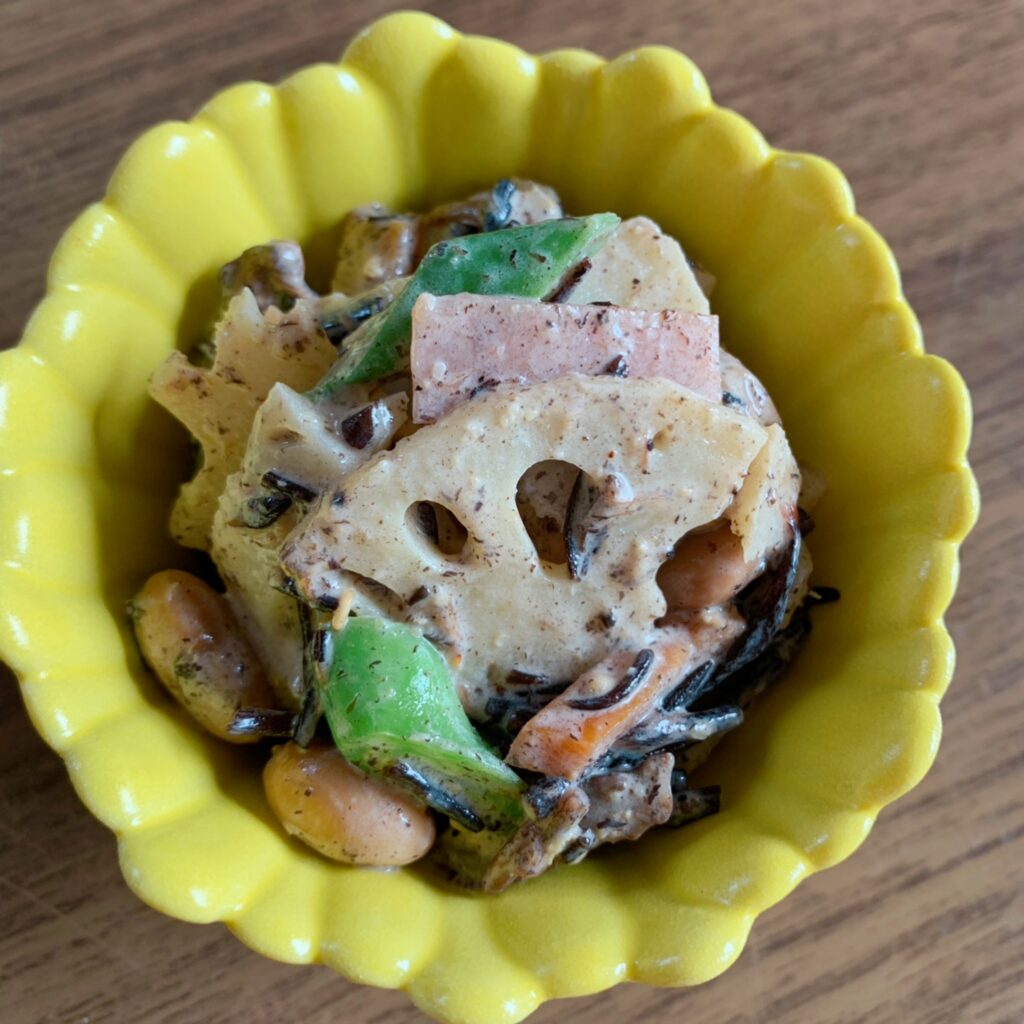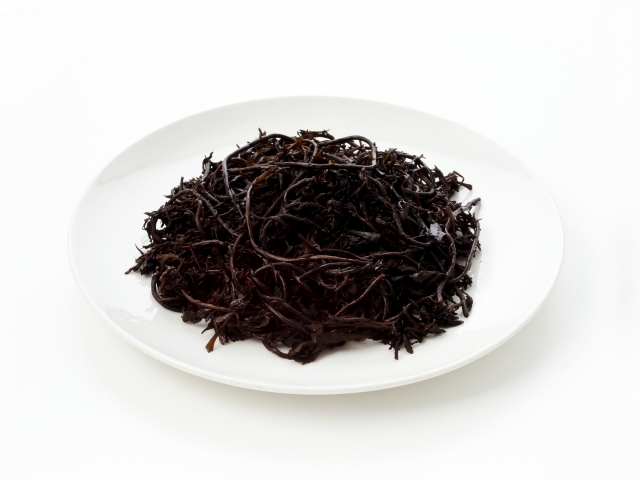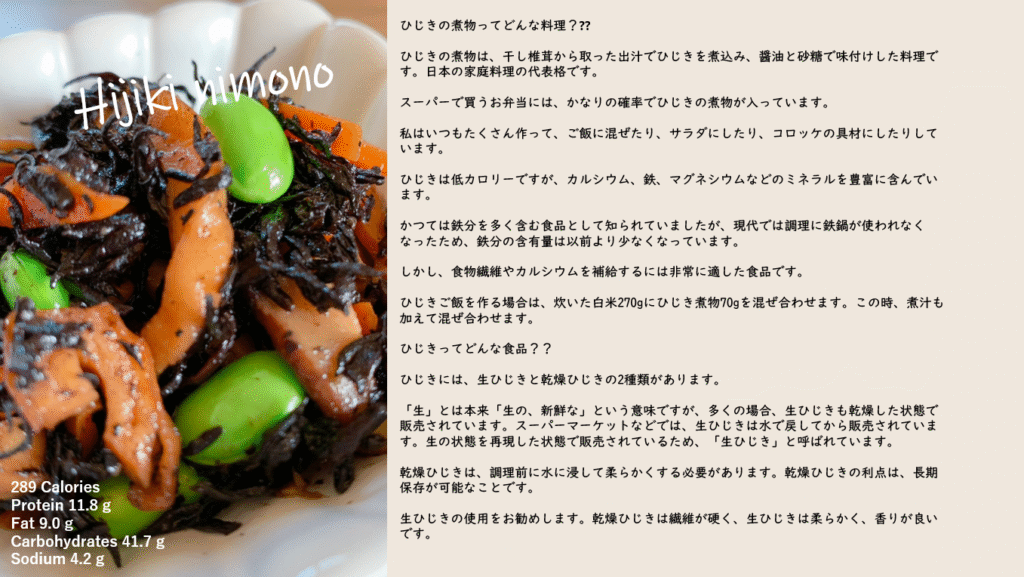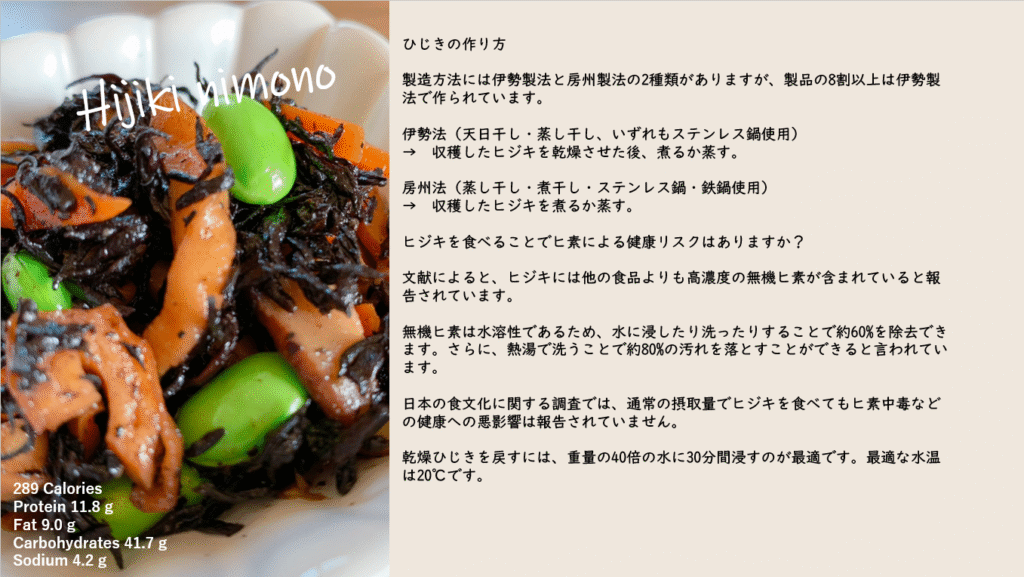
Hijiki no nimono (ひじきの煮物)
What kind of dish is Hijiki no nimono ⁇
Hijiki nimono is a dish made by boiling hijiki seaweed in a broth made from dried shiitake mushrooms and seasoning it with soy sauce and sugar. Hijiki nimono is a representative dish of Japanese home cooking.
hijiki=ひじき simmerd dish=煮物
There is a high probability that hijiki nimono will appear in bento boxes purchased at the supermarket.
I always make a lot and mix it with rice, make it into a salad, or use it as an ingredient for croquettes.

Hijiki is low in calories but contains a lot of minerals such as calcium, iron and magnesium.

Hijiki used to be known as a food that was high in iron, but nowadays, iron content is lower than it used to be because iron pots are no longer used in the cooking process..
However, it is a very suitable food for supplementing dietary fiber and calcium.
What kind of food is Hijiki ??
There are two types of hijiki: dried hijiki and nama hijiki.


“Nama” originally means “raw, fresh”. However, in most cases, nama hijiki is also sold in a dried state. Nama hijiki is rehydrated in water at supermarkets and other stores before being sold. It is called nama hijiki because it is sold in a state that reproduces its raw state.
Dried hijiki needs to be soaked in water before cooking to soften it. The advantage of dried hijiki is that it can be stored for a long time.
I recommend using raw hijiki. Dried hijiki has hard fibers, while raw hijiki is soft and has a good aroma.

How to make hijiki
There are two manufacturing methods, the Ise method and the Boshu method, but over 80% of the products use the Ise method.
- Ise method (sun-dried and steam-dried, all in stainless steel pots) → After drying the harvested hijiki, boil or steam it.
- Boshu method (steam-dried, boiled-dry, stainless steel pot/iron pot) → Boil or steam the harvested hijiki.

Are there any health risks associated with arsenic from eating hijiki?
It has been reported in the literature that Hijiki contains a higher concentration of inorganic arsenic than other foods.
Inorganic arsenic is water-soluble, so about 60% of it can be removed by soaking or washing with water.Furthermore, it is said that nearly 80% of the dirt can be removed by washing with hot water.
In a survey based on Japanese dietary culture, there have been no reports of adverse health effects such as arsenic poisoning caused by eating hijiki at normal intake levels.
The best way to rehydrate dried hijiki is to soak it in water 40 times its weight for 30 minutes. The optimal water temperature is 20°C.

NUTRITION FACTS:Healthy Hijiki Nimono Recipe (Simmered Hijiki Seaweed)
TOTAL NUTRITION VALUE

- 337 Calories
- Protein 13.0 g
- Total Fat 9.0 g
- Total Carbohydrates 50.9 g
- Sodium 6.4 g
- Dietary fiber 12.4 g
INGREDIENTS :Healthy Hijiki Nimono Recipe (Simmered Hijiki Seaweed) (5SERVINGS)

- Dried shiitake mushrooms 1piece 4g
- Water 150g
- Nama hijiki 150g
- Carrots 40g
- Fish cakes (satsumaage) 25g {You can also use fried tofu, chikuwa, pork, etc.}
- Sesame oil 5g
- Water and the water used to soak dried shiitake mushrooms total 400g
- ☆Dark soy sauce 30~40g
- ☆Sugar 10~15g
- ☆Mirin 20g
- ☆Sake 15g
- Frozen edamame 50g {Boiled soybeans or green peas can be used instead. }
If the dried shiitake mushrooms are not very flavorful, use 40g soy sauce and 15g sugar. Start with 30g soy sauce and 10g sugar, then adjust to taste. Until now, dried shiitake mushrooms have been mixed with other varieties in the same pack, resulting in different rehydration speeds and flavors even when soaked in water. There are efforts to avoid this and stabilize quality.
If you don’t have dried shiitake mushrooms, use fresh ones and add 2g of dashi no moto granules.
How to make Healthy Hijiki Nimono Recipe (Simmered Hijiki Seaweed)
Dried shiitake mushrooms should be soaked in water the day before. If you don’t have time, soak it in hot water for about an hour.
- Wash the nama hijiki under running water. (If using dried hijiki, soak in water for 5 ~20 minutes.)
- Drain the hijiki.
- Wash the carrots and peel them with a peeler.
- Slice the carrots and then cut them into thin strips.
- Cut the fish cake into 5mm x 2cm pieces.
- Cut off the stems of rehydrated dried shiitake mushrooms.
- Cut the dried shiitake mushrooms into 5mm x 2cm pieces. Don’t throw away the water you soaked the shiitake mushrooms in!
- Heat sesame oil in a frying pan.
- Quickly stir-fry hijiki, carrots, and shiitake mushrooms.
- Add the water that the dried shiitake mushrooms were soaked in. This is the secret to the deliciousness of this dish.
- Add water to adjust the amount so that all the ingredients are submerged.
- Boil the hijiki and carrot until they are soft. It will take about 10 minutes on low heat. Sometimes the hijiki can be surprisingly hard, so be sure to taste it.
- Add sake, sugar, mirin, and soy sauce.
- Stir occasionally and simmer over medium heat for 5 minutes.
- If using fresh beans, add them now. If you want to preserve the beautiful green colour of raw beans, boil them in a separate pot until soft and then add them just before turning off the heat.
- Add the fish cakes and frozen edamame beans.
- When the water has almost evaporated, turn off the heat, and let cool.
- Leave it overnight so the flavors can soak into the hijiki.
The reason for adding satsumaage at the end is to avoid the situation where the satsumaage absorbs the seasoning and the seasoning is not absorbed into the hijiki. Frozen edamame discolors easily, so add it to the frying pan just before turning off the heat.
If you want to make hijiki rice, mix 70g of hijiki nimono with 270g of cooked white rice. At this time, mix in the broth as well.



コメント